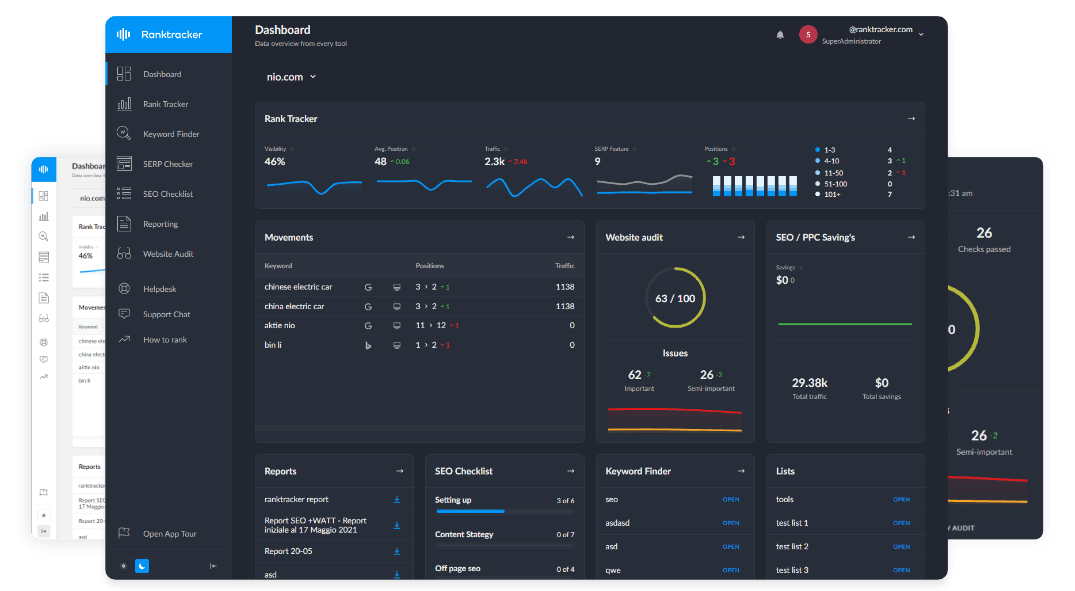Intro
If you run a franchise website, you already know the struggle. You’ve got dozens (sometimes hundreds) of location pages, each one fighting to get found in Google.
The problem? Most of them never see the light of day.
Why? Because internal linking is broken.
Google uses internal links to figure out which pages matter most, how your site is structured, and where to send link equity. When you don’t have a smart internal linking strategy, your local pages become “orphaned” islands, technically live, but invisible in search results.
The good news?
Internal linking is one of the easiest wins in SEO. Especially for franchise websites. With the right setup, you can funnel authority from your main franchise hub down to every local page, boost rankings in multiple cities, and make Google see your site as the trusted authority it already is.
The All-in-One Platform for Effective SEO
Behind every successful business is a strong SEO campaign. But with countless optimization tools and techniques out there to choose from, it can be hard to know where to start. Well, fear no more, cause I've got just the thing to help. Presenting the Ranktracker all-in-one platform for effective SEO
We have finally opened registration to Ranktracker absolutely free!
Create a free accountOr Sign in using your credentials
In this guide, I’ll break down exactly how to set up internal linking for franchise websites, what to avoid, what to implement, and the strategies that actually move the needle.
What Makes Internal Linking Critical for Franchise Websites?
Franchise websites face a unique SEO challenge: they’re big, complex, and spread across multiple locations.
Unlike a small business site with 5–10 pages, franchises often deal with dozens (or even hundreds) of near-duplicate pages.
That’s where internal linking comes in.
Think of it like a roadmap for Google. Internal links tell search engines:
-
Which pages are important (your main franchise hub, your most profitable services).
-
How pages are connected (service pages, location pages, blogs).
-
Where to send authority (passing link juice from your strong pages to the ones that need a boost).
For franchises, this is critical because:
- HQ needs to share authority with locations.
Without links from your main brand site, local pages stay weak. A Dallas plumbing franchise page won’t rank if all the authority is locked at the corporate homepage.
- Location pages need to connect with each other.
When locations link to nearby locations (“Looking for our services in Houston?”), it helps Google understand the network of franchise branches.
- Google loves structure.
A clear internal linking setup shows hierarchy:
Franchise HQ > State/Region > City > Service.
This hierarchy gives search engines confidence to rank your local pages higher.
The All-in-One Platform for Effective SEO
Behind every successful business is a strong SEO campaign. But with countless optimization tools and techniques out there to choose from, it can be hard to know where to start. Well, fear no more, cause I've got just the thing to help. Presenting the Ranktracker all-in-one platform for effective SEO
We have finally opened registration to Ranktracker absolutely free!
Create a free accountOr Sign in using your credentials
Bottom line: if you’re running a franchise site without a strong internal linking system, you’re leaving money (and rankings) on the table.
Common Internal Linking Mistakes on Franchise Sites
Here’s the truth: most franchise websites are full of internal linking mistakes. And these errors cost rankings every single day.
Some of the biggest ones I see:
- Orphaned location pages
Pages that aren’t linked anywhere on the site. If Google can’t find them through links, they may as well not exist.
- Linking only to the homepage
Corporate pages hog all the links, while the local service pages, the ones that actually bring in leads, get ignored.
- Using weak anchor text
“Click here” or “Learn more” doesn’t tell Google anything. Descriptive anchors like “plumbing services in Dallas” move the needle.
- Putting too many links on one page
Yep, more is not always better. If you stuff hundreds of links in your footer or on a service page, Google dilutes the value.
So how many internal links should you actually add?
According to Zenith, the general recommendation is simple: aim for about 5–10 internal links per 2,000 words.
Best Practices for Internal Linking Across Franchise Websites
Once you know what not to do, it’s time to build a system that works. Internal linking for franchises is all about creating a structure that funnels authority from the top (HQ) down to every single location and service page.
Here’s what works best:
1. Use a hub-and-spoke structure
Think of your franchise HQ page as the hub. From there, link out to regional/state pages (if you have them), then down to individual city or service pages. This creates a clean hierarchy:
** Franchise Homepage > State Page > City Page > Service Page**
Google loves this because it shows exactly how your pages are related.
2. Optimize your anchor text
Don’t just say “our services”, use descriptive anchors like “plumbing repair in Dallas” or “franchise tutoring in Houston.” These small tweaks help Google understand location + service relevance.
3. Add breadcrumbs
Breadcrumbs aren’t just good for UX. They also create a built-in web of internal links that reinforce your site structure. Example:
Home > Texas > Dallas > Plumbing Services
4. Link sibling locations together
If someone lands on your Dallas page, add a section like: “Also serving nearby: Houston | Austin | San Antonio.” This way, locations help each other rank and customers can find the closest branch.
5. Don’t forget service silos
Your service hub page (e.g., Water Heater Installation) should link to every city page that offers it. Likewise, those city service pages should link back to the hub.
This two-way linking signals to Google: “This is the authoritative page on the topic.”
Advanced Internal Linking Strategies
Once the basics are in place, you can use advanced tactics to give your franchise site an extra edge.
These strategies help you spread authority deeper into your site and make Google see your brand as the top choice in multiple markets.
1. Use blog posts as funnels
Every blog you publish should point to money-making pages.
For example, a blog on “5 Signs You Need a New Water Heater” should link directly to your Water Heater Installation > Dallas and Water Heater Installation > Houston pages.
This way, blogs act as link funnels into your location/service silos.
2. Create regional “pillar” pages
If your franchise operates across an entire state, build a state-level page that links to all local branches.
Example:
“Plumbing Services in Texas” > links to Dallas, Houston, Austin, and San Antonio pages.
These “middle-layer” pages give Google a strong geographic signal and help distribute link equity.
3. Build service silos
We touched on this earlier, but going deeper:
-
Your main service hub (e.g., “Roof Repair Services”) links to every local version of that service.
-
Each local service page links back up to the hub.
-
Bonus: interlink between cities that share the same service (Dallas Roof Repair > Houston Roof Repair).
This creates a reinforced loop that pushes both local and national visibility.
4. Contextual internal links
Don’t only rely on nav menus and footers.
Add contextual links inside paragraphs of content.
Example: On the Dallas plumbing page, a line like “Need emergency repairs? Our Houston team also offers 24/7 plumbing services nearby” spreads relevance and authority naturally.
5. Seasonal or promotional linking
If you run limited-time campaigns (e.g., “Spring A/C Checkups”), link those promotions across your relevant location pages. It keeps your site fresh and builds topical clusters that Google loves.
Internal Linking Tools & Tracking
You can’t fix what you can’t measure. That’s why auditing your internal links is just as important as setting them up. Luckily, there are tools that make the process simple:
1. Google Search Console (GSC)
Inside GSC, go to Links > Internal Links.
Here you’ll see which pages get the most internal links and which ones are ignored.
If your Dallas location page doesn’t show up on the list, that’s a red flag, it means Google isn’t seeing it as connected.
2. Screaming Frog
Run a crawl of your site with Screaming Frog. You’ll quickly spot:
-
Orphaned pages (no internal links)
-
Pages with excessive outbound links
-
Broken internal links that waste crawl budget
3. Ahrefs / Semrush
Both tools have an internal linking report where you can see which pages have the strongest authority (measured by URL Rating or Authority Score).
Use these “power pages” to funnel link juice down to weaker local/service pages.
4. Internal linking audit checklist
Every location page should have at least 3 - 5 internal links pointing to it.
Service hubs should connect down to local pages and back up.
Blog posts should always link to money pages (never leave them “dead-end”).
No page should be more than 3 clicks away from the homepage.
The All-in-One Platform for Effective SEO
Behind every successful business is a strong SEO campaign. But with countless optimization tools and techniques out there to choose from, it can be hard to know where to start. Well, fear no more, cause I've got just the thing to help. Presenting the Ranktracker all-in-one platform for effective SEO
We have finally opened registration to Ranktracker absolutely free!
Create a free accountOr Sign in using your credentials
Tracking this regularly ensures your franchise site stays healthy and every branch benefits from the brand’s overall authority.
Also Read, Benefits of Technology Guest Posting
Final Thoughts
Internal linking might not sound as flashy as backlinks or content marketing, but for franchise websites, it’s the glue that holds everything together.
Done wrong, you end up with orphaned pages, diluted authority, and local branches that never rank. Done right, you create a clear hierarchy where:
-
The corporate homepage shares its authority with every branch.
-
Location pages strengthen each other through smart interlinking.
-
Blogs and service hubs funnel authority to the pages that actually drive revenue.
The result? Google understands your site, users find the right branch faster, and every franchise location has a fighting chance to hit the top 3.
If you’re running a franchise site, internal linking isn’t optional, it’s your competitive edge.

